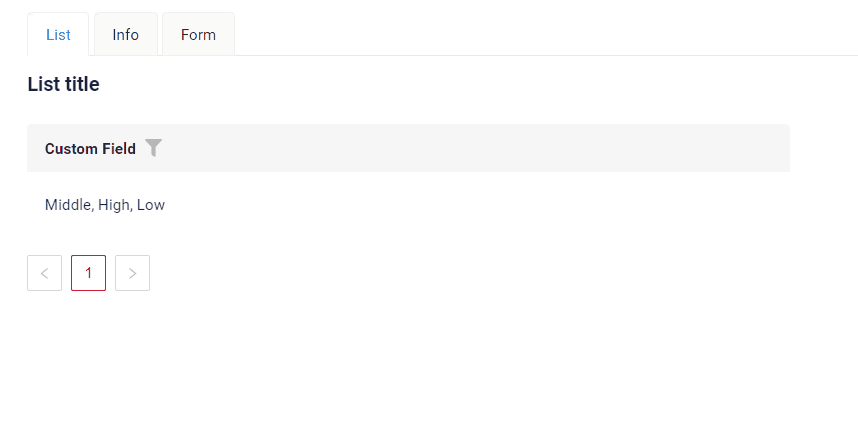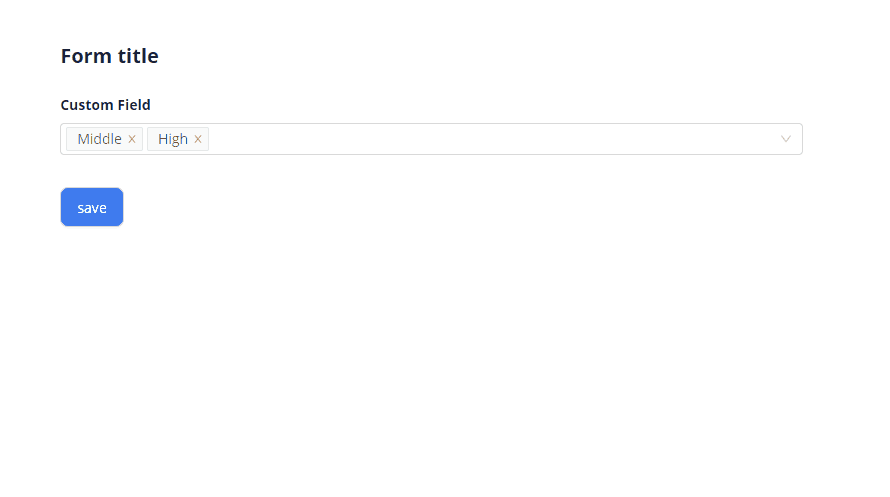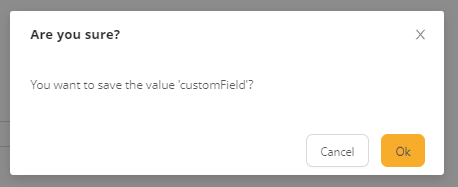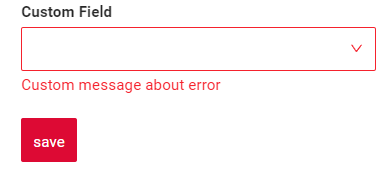MultipleSelect
MultipleSelect is a component that allows to select multiple values from dropdown list of predefined values
Tip
For this field type let's talk about number of rows in popup and number of selected rows.Number of rows in popup: Use for dictionaries or slowly-growing entities, e.g. no more than 1000 values (all values are loaded in memory). Otherwise, use multivalue.Number of selected rows: same limits as for 'Number of rows in popup'
Basics
How does it look?



How to add?
Example
Step1 Create Enum. Recommend that use const key value and dynamic value for visual display.
@Getter
@AllArgsConstructor
public enum CustomFieldEnum {
HIGH("High"),
MIDDLE("Middle"),
LOW("Low");
@JsonValue
private final String value;
public static CustomFieldEnum getByValue(@NonNull String value) {
return Arrays.stream(CustomFieldEnum.values())
.filter(enm -> Objects.equals(enm.getValue(), value))
.findFirst()
.orElse(null);
}
}
@Entity
@Getter
@Setter
@NoArgsConstructor
public class MyEntity extends BaseEntity {
@Enumerated(value = EnumType.STRING)
@CollectionTable(name = "CUSTOM_FIELD_251", joinColumns = @JoinColumn(name = "MyEntity_ID"))
@ElementCollection(targetClass = CustomFieldEnum.class)
@Column(name = "VALUE", nullable = false)
private Set<CustomFieldEnum> customField = new HashSet<>();
}
Step3 Add field Custom Field to corresponding DataResponseDTO.
@Getter
@Setter
@NoArgsConstructor
public class MyExampleDTO extends DataResponseDTO {
@EnumValueProvider.BaseEnum(value = CustomFieldEnum.class)
@SearchParameter(name = "customField", multiFieldKey = EnumValueProvider.class, provider = MultiFieldValueProvider.class)
private MultivalueField customField;
public MyExampleDTO(MyEntity entity) {
this.id = entity.getId().toString();
this.customField = entity.getCustomField().stream()
.collect(MultivalueField.toMultivalueField(Enum::name, CustomFieldEnum::getValue));
}
}
Step4 Add fields.setDictionaryTypeWithCustomValues to corresponding FieldMetaBuilder.
@Override
public void buildRowDependentMeta(RowDependentFieldsMeta<MyExampleDTO> fields, InnerBcDescription bcDescription,
Long id, Long parentId) {
fields.setDictionaryTypeWithCustomValues(MyExampleDTO_.customField, Arrays.stream(CustomFieldEnum.values())
.map(CustomFieldEnum::getValue)
.toArray(String[]::new));
fields.setEnabled(MyExampleDTO_.customField);
}
Step5 Add to .widget.json.
Step5 Add to .widget.json.
Step5 Add to .widget.json.
Placeholder
Placeholder allows you to provide a concise hint, guiding users on the expected value. This hint is displayed before any user input. It can be calculated based on business logic of application
How does it look?

not applicable

How to add?
Example
Add fields.setPlaceholder to corresponding FieldMetaBuilder.
@Override
public void buildRowDependentMeta(RowDependentFieldsMeta<MyExampleDTO> fields, InnerBcDescription bcDescription,
Long id, Long parentId) {
fields.setDictionaryTypeWithCustomValues(MyExampleDTO_.customField, Arrays.stream(CustomFieldEnum.values())
.map(CustomFieldEnum::getValue)
.toArray(String[]::new));
fields.setEnabled(MyExampleDTO_.customField);
fields.setPlaceholder(MyExampleDTO_.customField, "Placeholder text");
}
Works for List.
not applicable
Works for Form.
Color
not applicable
Readonly/Editable
Readonly/Editable indicates whether the field can be edited or not. It can be calculated based on business logic of application
Editable
Live Sample ·
GitHub
Readonly
Live Sample ·
GitHub
How does it look?

not applicable




How to add?
Example
Step1 Add mapping DTO->entity to corresponding VersionAwareResponseService.
@Override
protected ActionResultDTO<MyExampleDTO> doUpdateEntity(MyEntity entity, MyExampleDTO data,
BusinessComponent bc) {
if (data.isFieldChanged(MyExampleDTO_.customField)) {
entity.setCustomField(
data.getCustomField().getValues()
.stream()
.map(v -> CustomFieldEnum.getByValue(v.getValue()))
.collect(Collectors.toSet()));
}
return new ActionResultDTO<>(entityToDto(bc, entity));
}
@Override
public void buildRowDependentMeta(RowDependentFieldsMeta<MyExampleDTO> fields, InnerBcDescription bcDescription,
Long id, Long parentId) {
fields.setDictionaryTypeWithCustomValues(MyExampleDTO_.customField, Arrays.stream(CustomFieldEnum.values())
.map(CustomFieldEnum::getValue)
.toArray(String[]::new));
fields.setEnabled(MyExampleDTO_.customField);
}
Works for List.
not applicable
Works for Form.
Option 1 Enabled by default.
@Override
public void buildRowDependentMeta(RowDependentFieldsMeta<MyExampleDTO> fields, InnerBcDescription bcDescription,
Long id, Long parentId) {
fields.setDictionaryTypeWithCustomValues(MyExampleDTO_.customField, Arrays.stream(CustomFieldEnum.values())
.map(CustomFieldEnum::getValue)
.toArray(String[]::new));
}
Option 2 Not recommended. Property fields.setDisabled() overrides the enabled field if you use after property fields.setEnabled.
Works for List.
Works for Info.
Works for Form.
Filtering
Filtering allows you to search data based on criteria. Search uses in operator.
How does it look?

not applicable
not applicable
How to add?
Example
Step 1 Add @SearchParameter to corresponding DataResponseDTO. (Advanced customization SearchParameter)
@Getter
@Setter
@NoArgsConstructor
public class MyExampleDTO extends DataResponseDTO {
@EnumValueProvider.BaseEnum(value = CustomFieldEnum.class)
@SearchParameter(name = "customField", multiFieldKey = EnumValueProvider.class, provider = MultiFieldValueProvider.class)
private MultivalueField customField;
public MyExampleDTO(MyEntity entity) {
this.id = entity.getId().toString();
this.customField = entity.getCustomField().stream()
.collect(MultivalueField.toMultivalueField(Enum::name, CustomFieldEnum::getValue));
}
}
Step 2 Add fields.enableFilter to corresponding FieldMetaBuilder.
@Override
public void buildIndependentMeta(FieldsMeta<MyExampleDTO> fields, InnerBcDescription bcDescription,
Long parentId) {
if (configuration.getForceActiveEnabled()) {
fields.setForceActive(MyExampleDTO_.customField);
}
fields.setConcreteFilterValues(MyExampleDTO_.customField, Arrays
.stream(CustomFieldEnum.values())
.map(en -> new SimpleDictionary(en.name(), en.getValue()))
.collect(Collectors.toList())
);
fields.enableFilter(MyExampleDTO_.customField);
}
not applicable
not applicable
Drilldown
not applicable
Validation
Validation allows you to check any business rules for user-entered value. There are types of validation:
1) Exception:Displays a message to notify users about technical or business errors.
Business Exception:
Live Sample ·
GitHub
Runtime Exception:
Live Sample ·
GitHub
2) Confirm: Presents a dialog with an optional message, requiring user confirmation or cancellation before proceeding.
3) Field level validation: shows error next to all fields, that validation failed for
Option 1:
Live Sample ·
GitHub
Option 2:
Live Sample ·
GitHub
How does it look?




not applicable




How to add?
Example
BusinessException describes an error within a business process.
Add BusinessException to corresponding VersionAwareResponseService.
@Override
protected ActionResultDTO<MyExampleDTO> doUpdateEntity(MyEntity entity, MyExampleDTO data,
BusinessComponent bc) {
if (data.isFieldChanged(MyExampleDTO_.customField)) {
data.getCustomField().getValues()
.stream()
.filter(val -> val.getValue().equals(CustomFieldEnum.HIGH.getValue()))
.findFirst()
.orElseThrow(() -> new BusinessException().addPopup("The field can contain 'High'"));
entity.setCustomField(
data.getCustomField().getValues()
.stream()
.map(v -> CustomFieldEnum.getByValue(v.getValue()))
.collect(Collectors.toSet()));
}
return new ActionResultDTO<>(entityToDto(bc, entity));
}
Works for List.
not applicable
Works for Form.
RuntimeException describes technical error within a business process.
Add RuntimeException to corresponding VersionAwareResponseService.
@Override
protected ActionResultDTO<MyExampleDTO> doUpdateEntity(MyEntity entity, MyExampleDTO data,
BusinessComponent bc) {
if (data.isFieldChanged(MyExampleDTO_.customField)) {
entity.setCustomField(
data.getCustomField().getValues()
.stream()
.map(v -> CustomFieldEnum.getByValue(v.getValue()))
.collect(Collectors.toSet()));
try {
//call custom function
throw new Exception("Error");
} catch (Exception e) {
throw new RuntimeException("An unexpected error has occurred.");
}
}
return new ActionResultDTO<>(entityToDto(bc, entity));
}
Works for List.
not applicable
Works for Form.
Add PreAction.confirm to corresponding VersionAwareResponseService.
@Override
public Actions<MyExampleDTO> getActions() {
return Actions.<MyExampleDTO>builder()
.newAction()
.action("save", "save")
.withPreAction(PreAction.confirm("You want to save the value ?"))
.add()
.build();
}
Works for List.
not applicable
Works for Form.
Add javax.validation to corresponding DataResponseDTO.
Use if:
Requires a simple fields check (javax validation)
@Getter
@Setter
@NoArgsConstructor
public class MyExampleDTO extends DataResponseDTO {
@NotNull(message = "Custom message about error")
@EnumValueProvider.BaseEnum(value = CustomFieldEnum.class)
@SearchParameter(name = "customField", multiFieldKey = EnumValueProvider.class, provider = MultiFieldValueProvider.class)
private MultivalueField customField;
public MyExampleDTO(MyEntity entity) {
this.id = entity.getId().toString();
this.customField = entity.getCustomField().stream()
.collect(MultivalueField.toMultivalueField(Enum::name, CustomFieldEnum::getValue));
}
}
Works for List.
not applicable
Works for Form.
Create сustom service for business logic check.
Use if:
Business logic check required for fields
Step 1 Create сustom method for check.
private void validateFields(BusinessComponent bc, MyExampleDTO dto) {
BusinessError.Entity entity = new BusinessError.Entity(bc);
Boolean customFieldFlg = dto.getCustomField().getValues()
.stream()
.anyMatch(val ->
CustomFieldEnum.HIGH.getValue().equals(val.getValue()));
Boolean customFieldAdditionalFlg = dto.getCustomFieldAdditional().getValues()
.stream()
.anyMatch(val ->
CustomFieldEnum.HIGH.getValue().equals(val.getValue()));
if (Boolean.TRUE.equals(customFieldFlg)) {
entity.addField(
MyExampleDTO_.customField.getName(),
"Custom message about error"
);
}
if (Boolean.TRUE.equals(customFieldAdditionalFlg)) {
entity.addField(
MyExampleDTO_.customFieldAdditional.getName(),
"Custom message about error"
);
}
if (entity.getFields().size() > 0) {
throw new BusinessException().setEntity(entity);
}
}
Step 2 Add сustom method for check to corresponding VersionAwareResponseService.
@Override
protected ActionResultDTO<MyExampleDTO> doUpdateEntity(MyEntity entity, MyExampleDTO data,
BusinessComponent bc) {
validateFields(bc, data);
if (data.isFieldChanged(MyExampleDTO_.customField)) {
entity.setCustomField(
data.getCustomField().getValues()
.stream()
.map(v -> CustomFieldEnum.getByValue(v.getValue()))
.collect(Collectors.toSet()));
}
if (data.isFieldChanged(MyExampleDTO_.customFieldAdditional)) {
entity.setCustomField(
data.getCustomField().getValues()
.stream()
.map(v -> CustomFieldEnum.getByValue(v.getValue()))
.collect(Collectors.toSet()));
}
return new ActionResultDTO<>(entityToDto(bc, entity));
}
Sorting
not applicable
Required
Required allows you to denote, that this field must have a value provided.
How does it look?

not applicable

How to add?
Example
Add fields.setRequired to corresponding FieldMetaBuilder.
@Override
public void buildRowDependentMeta(RowDependentFieldsMeta<MyExampleDTO> fields, InnerBcDescription bcDescription,
Long id, Long parentId) {
fields.setDictionaryTypeWithCustomValues(MyExampleDTO_.customField, Arrays.stream(CustomFieldEnum.values())
.map(CustomFieldEnum::getValue)
.toArray(String[]::new));
fields.setEnabled(MyExampleDTO_.customField);
fields.setRequired(MyExampleDTO_.customField);
}
Works for List.
not applicable
Works for Form.